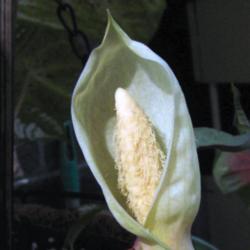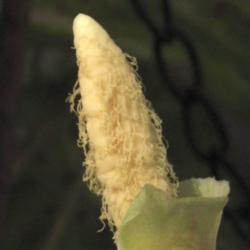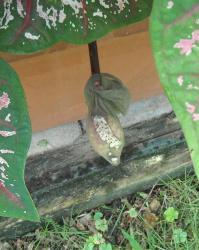Ack .. sorry .. you're right - I got it backwards .. female receptive before pollen release. I've returned your Acorns! Here is the link (it starts about halfway down the page) and info I where I read this:
http://happinessfarms.com/askt...
Question: How do you breed caladiums?
Answer: (First of a series: Introduction) This cannot be answered without a lot of explanation and dialogue. Since I have had many requests for this information, I am going to do a series of articles giving you the basics of caladium breeding, my objectives, and successes. Introduction: Caladiums are tropical plants, with a center of origin in South America, specifically Brazil. They are members of the aroid family, related to the green elephant ear, taro, and tapioca plants. They form tubers, similar to a potato, with numerous eyes that develop into leaves. The plants are very cold sensitive and prefer temperatures above 65°F and lots of moisture. If the plants get cold, the leaves will wilt and the tubers will go into a resting stage for eight to ten weeks. Dry weather will also cause dormancy, as the roots will dry up and the plant goes to sleep. This is a natural occurrence in the tropics where the seasons are more noticeable between wet/dry than cold/warm. The flower of a caladium consists of a spathe (the fleshy outer covering) and a spadix (the conical inner stalk that contains the male and female flowers). The male flowers are at the tip of the spadix, a sterile area of tissue is in the middle, and the female flowers are at the base. Caladiums are “protogynous”, which means that the female flowers are receptive before the male flowers shed their pollen. This is why you rarely observe seed on your caladium flowers. The female flowers have to be pollinated from the pollen of another flower on the plant or another plant. Most people cut off the flowers, as these structures can use some of the nutrients that could be going to the leaves, which are why we grow caladiums in the first place. A good reference on hybridization of caladiums is: Hartman, R.D., F.W.Zettler, J.F.Knauss, and E.M.Hawkins. 1972. Seed propagation of caladium and dieffenbachia. Proceedings Florida State Horticultural Society, pages 404-409. Following articles will provide you with this methodology…. keep looking at our web page for the latest installment.
Question: How do you breed caladiums? (second in a series: Breeding Objectives)
Answer: Although people in Europe, South America and the United States have been hybridizing caladiums for the past 150 years, nobody has produced that perfect caladium that meets all the criteria of perfection. The perfect caladium cultivar should have brightly colored leaves, be unique in its color pattern, have strong upright leaves, produce many leaves, be tolerant of the major diseases, such as Fusarium and Erwinia, be resistant to nematodes, and produce large multi-segmented tubers. The plants should grow early in the spring and have some cold tolerance so that they can be grown in regions of the country that have cool nights, even in the summertime. That is a lot to ask of one plant, but all breeders have to set the ultimate goals in their hybridization. Some helpful hints to start you in breeding are: 1) If you cross a solid red fancy leaf (Florida Cardinal) with a netted venation fancy leaf (Candidum), all of the progeny will have some degree of netted venation with a prominent red main vein; 2) If you cross any of these progeny back to a netted type, half of the seedlings will be netted and half will be netted with a red main vein (White Queen); 3) If you cross a netted type with a cultivar that has large blotches (White Christmas), half of the seedlings will be netted and half will have large blotches; 4) If you self pollinate a netted type that has a red main vein, one quarter of the progeny will be netted with a green main vein, one half will be netted with a red main vein, and one quarter will have a solid red center; and 5) If you cross a plant that has both pink and white spots with a plant that has no spots, one half of the seedlings will have pink spots and one half will have white spots. There are also modifying genes that cause the intensity of the pink to vary from a light pink to a dark rose. Red spots are also inherited in the same manner. This gives you some idea of the complexity of caladiums and how one can spend 30+ years trying to find the “right” plant, as I have done. If anyone cares to know more of the inheritance of other characteristics, drop a note to our web page. A good reference to start your reading on caladium genetics is: Zettler, F.W., and M.M. Abo El-Nil. 1979. The Journal of Heredity 70:433-435.
Question: How do you breed caladiums (Third in a series: Gibberellic Acid Soak)
Answer: Not all caladium cultivars readily make flowers when they are planted in containers or in the landscape, nor do they flower at the same time. Sometimes they flower when one least expects it, such as after just a few leaves have unfurled. People often ask what they are and if they should cut them off. Since they add very little decorative value to the plants, the flowers should be cut off just above where they emerge from the leaves, unless of course you want to hybridize. Back in 1979, we learned how to fool Mother Nature into getting the caladiums to flower consistently and fairly uniformly. Tuber size has a big influence on flowering, as the larger tubers (Jumbo and Mammoth) produce more flowers than the smaller tubers. We found that soaking the tubers for eight (8) hours in a 250-500 ppm solution of Gibberellic Acid prior to planting, enhanced flowering over those tubers soaked in water, with plants flowering about 60 days later. Each tuber treated with Gibberellic Acid yielded about three (3) flowers. The 10 inch pots should be planted with 4 to 5 jumbo or 3 mammoth tubers, with about 3 to 4 inches of soil over the top of the tubers. Leaves should begin to unfurl within 2 to 3 weeks and the flowers should be mature in about 60 days. If your plants are already growing and you want to get them to flower, spray the base of the plants to a heavy runoff (sprenching) with a 500 ppm solution of Gibberellic Acid. I found that cutting off all the leaves about 2 inches above the pot prior to applying the Gibberellic Acid allowed the spray to get to the base of the leaves easier. Some cultivars will produce numerous flowers while others produce few. Try to get as many pots as you can started in the early spring in order to get a second flush of flowers in August to double your chances of getting the crosses that you want. I would suggest that you initially cross some of the solid red fancy leaf types (such as Florida Cardinal, Poecile Anglais, Postman Joyner, and Buck) and some of the red lance leaf types (Florida Ruffles and Red Frills) among themselves. When you get more ambitious, you can incorporate plants with netted venation, spots, and blotches. A good reference to this method is: Harbaugh, B.K. and G.J. Wilfret. 1979. Gibberellic Acid (GA3) stimulates flowering in Caladium hortulanum Birdsey. HortScience 14(1): 72-73.
Question: How do you breed caladiums? (Fourth in a series: Pollination)
Answer: Once you see the flowers begin to develop and elongate, your adrenalin should start to flow and the excitement begins in anticipation of actually hybridizing plants. Remember that caladiums are protogynous, meaning that the female flowers are receptive before the male flowers shed their pollen. Actually, the female flowers on the caladium inflorescence (the spadix) are receptive about three (3) days before anthesis (pollen visible). The spadix is covered by a green leafy structure called a spathe, which turns a creamy white color when it unfurls. Unfortunately, when the spathe unfurls to reveal the spadix, the female flowers are no longer receptive and are covered with a gelatinous mass that inhibits pollen tube development. To understand the pollination of caladiums in nature, one has to assume that some insect (probably a beetle) bores a hole in the spathe in search of the nectary to get a sweet drink. He probably has visited other mature caladium flowers in close proximity and some of the pollen from these flowers has attached to his legs and body. As he roams around inside the unfurled spathe, he walks over the female flowers and pollinates them with the attached pollen. If you exam the spadix, the female flowers are at its base, closest to the nectary, and the male flowers are at the uppermost tip. So, how do you know when the female flowers are receptive? As the spathe develops, it is medium to light green in color, depending upon the cultivar. Sometimes, it even has white blotches on it. One has to observe the developing spathe carefully, waiting for a change in color along the margins where they overlap. When the margins of the spathe just start to turn creamy white, the female flowers are receptive. At this point, one takes a sharp scalpel or knife and carefully circumcises the spathe about one quarter inch above its base. Do not cut too deep or you will damage the female flowers. If you have done this correctly, the spathe will slip off the spadix, revealing the inflorescence. Now, collect pollen from another flower that has matured and brush the pollen all around and over the female flowers. The pollen will survive for 2 to 3 days on the female flowers if you have started too early. Remember, if the female flowers are covered with a sticky substance, you waited too long to pollinate. Repeat these steps for as many flowers as develop. You can try to store pollen in plastic containers (I use 35 mm film canisters) in the refrigerator for a few days or you can put the canisters in the freezer for a few months. I have had limited success with pollen frozen longer than 4 months. Maybe the tropical nature of the plant prevents freezing of the pollen. Would be a good research project for a science student. Good luck with your pollinations and continuing reading our web page for more in this series, such as what to do next!




